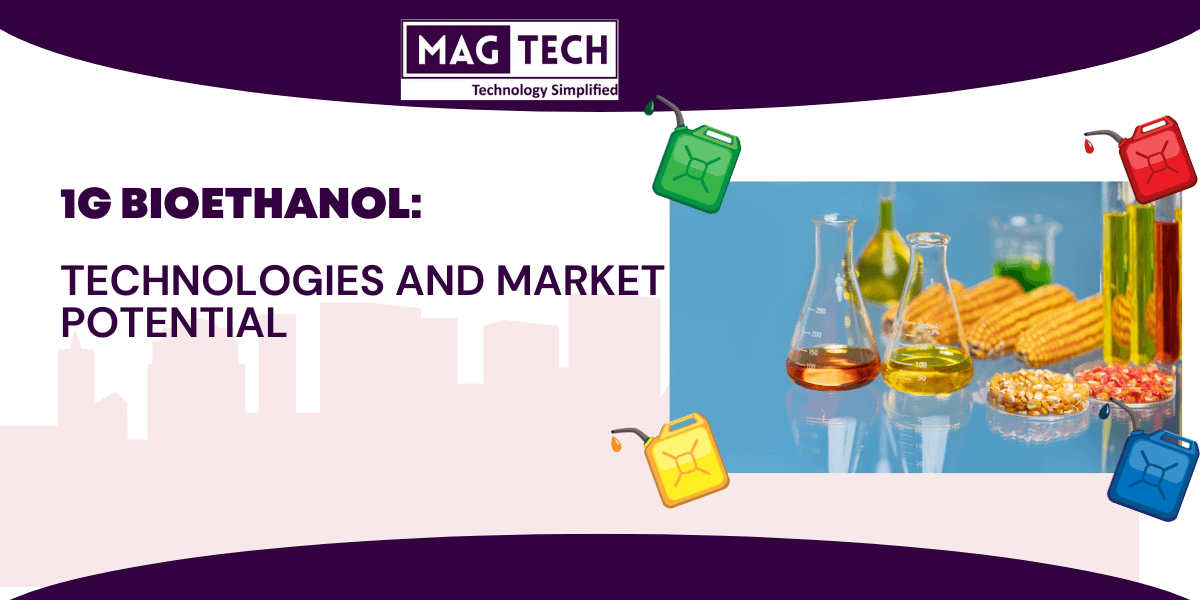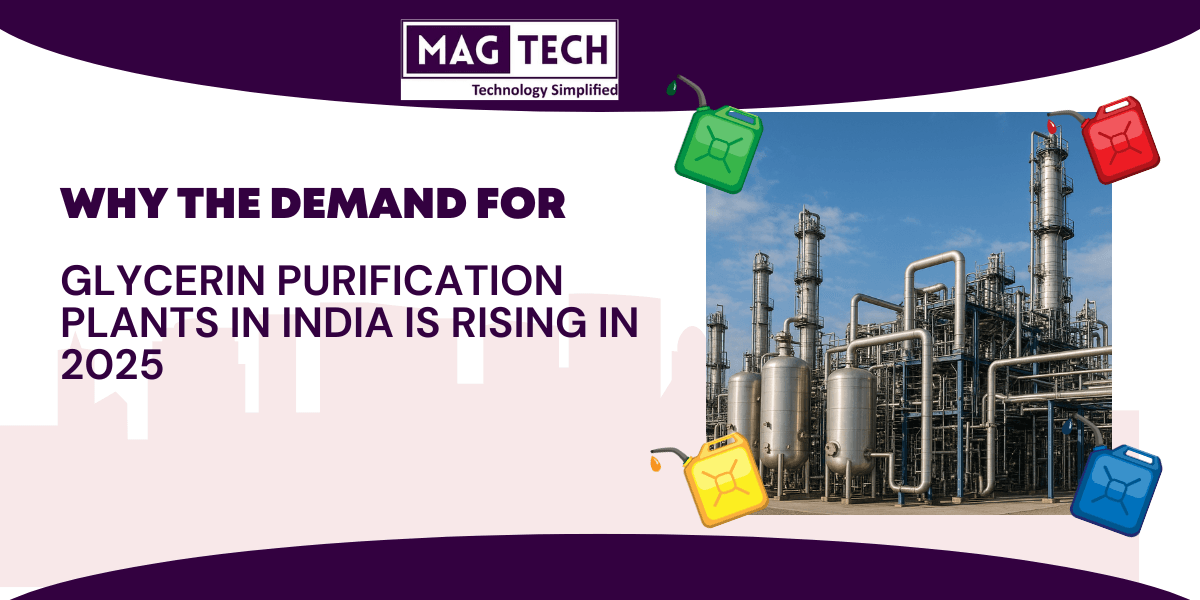Starting a glycerine purification plant can significantly boost the profitability of a biodiesel manufacturing unit. Crude glycerin, a byproduct of biodiesel production, often contains impurities that limit its market value. Manufacturers can transform this low-value byproduct into high-grade glycerin suitable for industries like cosmetics, pharmaceuticals, and food production by purifying glycerin.
This additional revenue stream not only offsets biodiesel production costs but also enhances overall profitability. Moreover, it promotes sustainability by reducing waste and maximizing resource utilization. This purification unit makes the entire operation more economically viable and environmentally friendly.
Let us understand the glycerin purification process to get an idea of how a purification unit can be set in a biodiesel production plant.
Table of Contents
ToggleUnderstanding Glycerine Purification–
Glycerin is a key byproduct of biodiesel production. For every 100 liters of biodiesel made, about 10 liters of crude glycerin is produced. This crude glycerin’s impurities, such as methanol, water, and soap, consequently limit its value in the market. Glycerin, therefore, needs to undergo a purification process in order to make it more profitable.
Key Steps:
1. Pre-treatment: The crude glycerin is first filtered to remove solid impurities. Then, sulfuric acid, consequently, treats it to break down any remaining soap. The acid oil is separated from the glycerin in a decanter.
2. Neutralization and Methanol Removal: After pretreatment, the glycerin is neutralized with caustic lye. Then, it is heated and placed under a vacuum to remove any leftover methanol.
3. Moisture Removal: The glycerin is further dried to reduce its water content. This is done using a vacuum dryer after preheating the glycerin with steam.
4. Distillation and Evaporation: The glycerin is distilled to separate it from remaining impurities, followed by thin-film evaporation to remove moisture and salts.
This process converts low-value crude glycerin into high-quality, purified glycerin, which can be sold to industries for further use. Setting up a glycerin purification plant depends on the infrastructure of a biodiesel production plant. If set together, the integration process becomes a lot easier. Here is what you need to set up a purification plant.
Steps to Set a Glycerine Purification Plant:
Establishing a glycerine purification plant along with a biodiesel plant needs proper planning and supervision. Not just financial, resource planning is a crucial part of this venture.
1. Do Feasibility Study First:
Before starting a glycerin purification plant, conducting market research and a feasibility study is crucial. Understanding the demand for purified glycerin will help you plan your production. Purified glycerin is used in many industries, such as cosmetics, pharmaceuticals, and food. The global demand for glycerin is increasing, especially in these sectors, making it a profitable product to offer.
Start by identifying potential buyers in your region. Research which companies or industries need glycerin. Assess their specific requirements for purity, packaging, and delivery. This will help you determine, furthermore, what grade of glycerin to produce and, in addition, how to market it.
Next, evaluate the availability of crude glycerin. Since biodiesel production creates it as a byproduct, connecting with biodiesel manufacturers for a steady supply is essential. Investigate local biodiesel plants and suppliers.
Additionally, calculate your production costs. Factor in equipment, labor, raw materials, utilities, and transportation. Compare this with potential revenue to gauge profitability. A thorough feasibility study will outline expected costs, risks, and returns, helping you plan for sustainable growth.
2. Location of Glycerine Purification Plant:
Choosing the right location for your glycerine purification plant is crucial for its success. The site should be close to biodiesel plants that produce crude glycerin. This will reduce transportation costs and ensure a steady supply of raw materials. Proximity to your market is also important. Being near industries that use purified glycerin, such as cosmetics and pharmaceuticals, can not only help with timely delivery, but also lower shipping costs.
Additionally, ensure the location has access to essential utilities like electricity, water, and natural gas, as these are needed for the purification process. Adequate road and transport infrastructure is vital for moving raw materials and finished products.
Check local zoning laws and environmental regulations. You’ll need the proper permits to operate, especially concerning waste disposal and emissions. Finally, consider labor availability in the area to ensure you can hire skilled workers for your plant’s operations.
3. Key Regulatory Requirements:
Starting a glycerine purification plant requires meeting several regulatory requirements. These regulations ensure that, as a result, your plant operates safely, meets environmental standards, and ultimately produces quality products. The specific domains that meet the regulatory requirements are, in fact, here.
- Business Licenses: You’ll need to register your company and obtain the necessary business licenses. This includes local permits and approvals from government bodies for running a manufacturing facility.
- Environmental Permits: Therefore, chemicals and processes involved in glycerin purification can create waste and emissions. You must get environmental clearances to ensure safe disposal of waste and meet pollution control standards. Authorities will inspect your plant for air and water pollution control systems. Proper waste treatment, disposal, and water usage are regulated.
- Fire Safety: Your plant must comply with fire safety standards. Glycerin and other chemicals used in the process can be flammable. Install fire alarms, extinguishers, and emergency exits. Regular inspections by local fire authorities are necessary.
- Health and Safety Standards: Workers at the plant will be handling chemicals and machinery. Compliance with labor laws is required. Therefore, ensure that employees use personal protective equipment (PPE) and, in addition, receive regular training on handling hazardous materials in order to maintain safety.
- Quality Standards: If you plan to sell glycerin for food, cosmetics, or pharmaceuticals, the final product must meet industry-specific quality standards. Therefore, ensure that the glycerin passes lab tests for purity and, additionally, complies with any food or drug administration guidelines in your region.
Compliance with these rules is the key to avoiding legal issues and fines. Finally, ensure that you consider labor availability in the area to hire skilled workers for your plant’s operations.
4. Financial Planning and Funding:
Financial planning and funding are critical steps in starting a glycerin purification plant. A well-structured financial plan will, therefore, enable you to estimate costs, explore funding options, and, ultimately, project your return on investment (ROI).
4.1 Cost Breakdown-
Start by estimating the total costs associated with setting up and running the plant. This includes:
- Land Costs: The price of land varies by location. Consider factors such as size, zoning regulations, and proximity to suppliers and markets.
- Machinery Costs: Budget for essential equipment, including filtration systems, distillation columns, evaporators, and drying equipment. Research and obtain quotes from multiple suppliers to find competitive prices.
- Operational Costs: Include expenses for labor, utilities, maintenance, raw materials, and transportation. Create a monthly budget to help manage ongoing expenses effectively.
4.2: Options for Funding-
Explore various funding sources to finance your plant:
- Bank Loans: Traditional bank loans can provide the necessary capital for purchasing equipment and land. Prepare a solid business plan to present to lenders, highlighting your project’s feasibility and potential profitability.
- Investor Capital: Seek out investors who are interested in supporting renewable energy projects. Presenting a compelling case about the growth potential of purified glycerin can attract investors willing to provide funding in exchange for equity.
4.3: Return on Investment (ROI) Expectations-
Calculate your expected ROI to demonstrate the profitability of your plant. Analyze production costs against projected sales revenue. A well-planned ROI analysis will help you understand how quickly you can recoup your investment.
4.4: Importance of a Solid Business Plan-
A solid business plan is essential for financing approval. It should outline your goals, market research, financial projections, and operational strategies. Lenders and investors want to see that you have a clear vision and a plan to achieve it.
5. Setting Up the Plant:
Setting up a glycerin purification plant involves several steps, from designing the facility to installing the necessary equipment. Each phase plays a vital role in ensuring efSetting up a glycerin purification plant involves several steps; first, from designing the facility to subsequently installing the necessary equipment.ficient production and compliance with regulations. Here’s a detailed guide on how to set up your plant.
5.1: Facility Design and Layout-
First, design a layout that optimizes the flow of materials and minimizes contamination. The plant should, therefore, have separate areas for receiving crude glycerin; additionally, there should be designated spaces for pre-treatment, purification, and packaging. Ensure there are adequate storage spaces for raw materials and finished products. Safety features, such as emergency exits and fire suppression systems, should be integrated into the design.
5.2: Equipment Selection and Installation-
Based on the equipment lineup you previously provided, the following systems are crucial for glycerin purification:
5.2.1: Pre-treatment Equipment-
- Solid Filtration: First, install a solid filtration system; subsequently, this will effectively remove suspended solids from crude glycerin. This step is, therefore, essential for preventing equipment damage and, furthermore, ensuring the quality of the final product.
- Acidification and Oil Separation: First, set up a gravity-settling decanter to separate the acid oil from the glycerin; then, subsequently, proceed by adding sulfuric acid.
- Neutralization and Methanol Removal: Equip the facility with caustic lye tanks for neutralization. Use a vacuum system to heat and, consequently, remove residual methanol efficiently.
5.2.2: Drying Equipment-
Moisture Removal System: Install a vacuum dryer to reduce moisture content. This will involve, first, preheating the glycerin with steam; subsequently, it will be fed into the dryer.”
5.2.3: Distillation Column-
Distillation Equipment: Structured packing beds, therefore, in a glycerin distillation column are essential for purification.. The column should include a reboiler for heating; furthermore, it should also have a pump around the system to cool the vapor. Additionally, this configuration will enhance overall efficiency.
5.2.4: Thin-Film Evaporator-
Matter Organic Non-Glycerol (MONG) and Salts Removal: Use a thin-film evaporator, therefore, to handle the bottoms from the distillation column. This equipment will vaporize glycerin and MONG; consequently, it allows for the removal of concentrated salts
5.2.5: Bleaching and Filtration Equipment-
- Color Removal: Activate carbon filters are necessary for bleaching the glycerin and removing color.
- Final Filtering System: Install a filtration system to ensure the final product is free from impurities and meets industry standards.
5.2.6: Utilities and Infrastructure-
Ensure your plant has access to essential utilities. This includes:
- Electricity: A reliable power supply to operate machinery and equipment.
- Water Supply: Clean water for processing and cooling.
- Natural Gas or Steam: Required for heating during various purification processes.
6. Safety Protocols-
Implement safety protocols throughout the facility. For instance, this includes installing safety equipment like fire extinguishers, eye wash stations, and safety showers. Therefore, provide training for employees on emergency procedures; furthermore, ensure proper handling of chemicals.
7. Hiring and Training Staff-
Hire skilled personnel to operate and manage the plant. Ensure they receive training in safety procedures, equipment operation, and maintenance. Furthermore, regular training sessions will help keep staff updated on best practices and safety regulations.
8. Testing and Quality Control-
Before starting production, thoroughly test all equipment and processes. Establish quality control measures to ensure the final glycerin product meets industry standards. Regular audits and monitoring will help maintain quality throughout production.
Careful Planning Leads to Glycerine Purification Plant Establishment Success:
Careful planning and investment in the right technology lead to adherence to safety and regulatory standards. By following these steps, you can establish a successful operation that enhances the profitability of your biodiesel manufacturing unit.
MAGTECH: Explore the Potential of Glycerine Purification Plant with Biodiesel Production:
Starting a glycerine purification plant can greatly enhance the profitability of your biodiesel operations. With MAGTECH as your trusted solution provider, you can access state-of-the-art technology and expert support to transform crude glycerin into high-quality products. Don’t miss out on this opportunity to maximize your returns and contribute to sustainability. Contact MAGTECH today to discuss how we can help you set up your glycerin purification plant!


